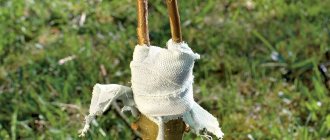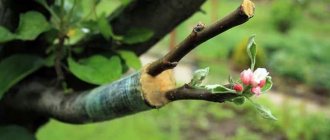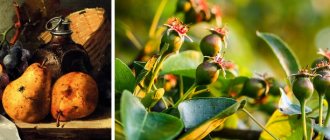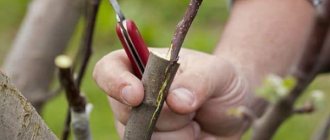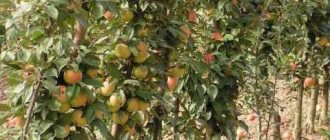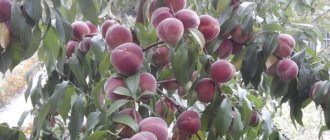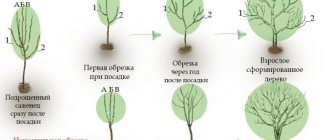Why do you need to graft peaches?
Peach grafting is an integral part of obtaining a quality harvest. This procedure allows you to grow southern trees even in cold regions. Sometimes it can be called the only method that allows preserving rare varieties of garden crops.
Grafted tree with fruits
By grafting a peach it is possible to achieve:
- cultivation of wild plants and cultivation of varietal peaches on them;
- replacing one variety with another that suits you better;
- growing several types of fruits on one tree at once;
- accelerated harvesting process;
- saving a tree in case of damage to the bark by rodents;
- propagation of favorite or simply rare varieties.
Necessary tools for the procedure
To carry out the procedure, you should use sharp and clean instruments. Thanks to their use, it is possible to obtain smooth cuts without fringes or burrs.
Secateurs
Experienced gardeners who often vaccinate use special pruning shears. They are quite expensive, but allow you to obtain grooves of the required sizes.
Garden knife
When using this tool, it is recommended to keep it sharp. Before and after gardening work, the knife should be disinfected.
Wood hacksaw
In some situations it is impossible to do without using a hacksaw. This device is usually required for old trees.
When to plant peach in spring and summer: optimal timing
How to graft apricot onto apricot in spring using green cuttings
It’s worth checking out how to plant a peach in the spring. It is recommended to perform the procedure before the process of sap flow begins. During this period, the kidneys are still dormant. The timing depends on the chosen procedure method. In the southern regions of Russia, vaccination is done more often in March, in the middle zone - in May. The weather conditions of the current seasons and the condition of the crops should be taken into account. The air temperature should be positive at any time of the day. After all, negative indicators can lead to rejection of the scion.
Note! It is permissible to vaccinate peach trees in the summer. At this time, the buds on the shoots have already matured, and shoot growth has almost stopped.
Recommended timing
The effectiveness of the measures taken depends on the seasonal factor. Spring is considered the most favorable period, but the procedure can be performed in other seasons.
Spring
Taking into account the climate, it is permissible to graft peach from March 15 to the end of April. It is important that a stable positive temperature be established, since there is a risk of damage to conductive tissues by spring frosts.
After a frosty winter, vaccination can be postponed a little.
Thanks to this, it will be possible to determine the severity of frost damage to branches. When performing the manipulation at the end of March, the grafted area should be wrapped in a plastic bag. If the manipulation is performed in April, use paper.
Summer
Vaccination in the summer also gives good results. However, it can be early and performed in the first half of June. The summer procedure is carried out in June-July. In August, peach trees are usually not grafted.
Autumn
It is not worthwhile to vaccinate peach trees in the autumn. In such a situation, there is a high probability of the scion freezing in winter.
What can a peach be grafted onto?
Apricot Black Prince - description and history of fruit selection
Thanks to this procedure, you can not only increase the yield, but also diversify it with different types of fruits in one garden, even with small parameters. To do this, you need to know what the peach is grafted on.
Is it possible to graft a peach onto an apricot?
Grafting peach onto apricot is quite appropriate, because these crops have excellent compatibility with each other. Apricots are universal peach rootstocks. After all, most of their varieties are frost-resistant and grow on different types of soil. Peach grafting should be carried out on Veteran, Juicy, Greensboro, and Redhaven apricots.
Compatible crops are quickly grafted
Is it possible to graft a peach onto a plum?
There are also cultures to which peach is grafted. If a gardener has decided to graft a peach onto a plum in his plant nursery, it is worth choosing varieties that are easy to care for, hardy and frost-resistant.
Note! For the middle zone of a country with a temperate climate, plum is one of the most suitable rootstocks for peach.
Benefits of Peach Grafting on Peach
It is optimal to make a peach rootstock similar to a peach, but of a more hardy variety or a wild one. Before you learn how to graft a peach onto a peach, it is worth considering the advantages of the procedure:
- most likely the grafted variety will bear fruit better;
- the rootstock is accepted faster;
- A peach tree is more suitable for a fresh cutting.
Compatibility of peach with other fruit trees
Almond, peach, cherry plum and cherry seedlings are often used as rootstocks for peach. Bitter almond seedlings are vigorous rootstocks for peach. They combine quite well with all its varieties. The tree on this rootstock is early-bearing, the first fruits appear 3-4 years after planting.
What is tree grafting
It’s worth starting, of course, by defining what this procedure is and why it is necessary. So, with the help of grafting, it becomes possible to get a fruit tree of the desired variety in your garden plot. In this case, you do not need to buy a seedling; it is enough that there is only a shoot and, naturally, a base on which this cutting will be planted. In other words, the cutting or bud engrafts on another plant.
This method of vegetative propagation has long been used in various nurseries, and now it is increasingly relevant in home gardening. Let's say you purchased a plot of land that already has a garden, but after the first harvest you realized that the quality of the fruit is far from what was desired. What to do in this case? After all, replacing all trees is a rather labor-intensive procedure, and the first more or less normal harvest can only be harvested after at least 6 years. The way out of this situation is vaccination. In addition, it is also used for damaged branches.
What should the rootstock be like?
Pruning peach in summer and how to do it correctly
For the procedure to be completed successfully, the rootstock should be selected in compliance with the following indicators:
- the cutting must have sufficient frost resistance for a particular region, resistance to drought or waterlogging, and other negative factors characteristic of the local climate;
- Compatibility with scions is encouraged. Stone fruits should be grafted onto seedlings of the same kind;
- It is worth taking into account the botanical relationship, because the closer it is, the higher the success rate.
Note! Only plants from the Rosaceae family are suitable for peach as a rootstock.
How to care for a grafted tree
At least a month must pass, after which you can remove the bandage placed on the tree during grafting. After this, the traditional procedure is to treat the cut with garden varnish. Even with successful grafting, the viability and fruiting of a peach largely depends on its maintenance and care. The tree's needs are small, but any necessary work must be carried out in a timely manner, these include the following:
The grafted peach needs to be watered once every one and a half or two weeks, taking into account the quality of the soil and the weather - approximately 10–15 liters of water are poured into the tree trunk area;
often young shoots form at the grafting site, which must be removed regularly, otherwise the roots of the plant will develop, and not its crown and fruits; It is important to periodically inspect trees and identify the appearance of insects and diseases; it is better to carry out preventive spraying with safe fungicidal and disinfectant preparations.
You will learn more about how to drive a peach with an inverted kidney in the following video.
Peaches are best planted in late spring. It happens that trees freeze over, and if the buds have not yet begun to bloom, it is not clear whether they are alive. It all started when an old peach froze in our garden. I didn't want to lose this variety. My father taught me how to graft trees, and my grandfather taught him.
I was confident that I would cope with the task. The only problem was that the buds on the small surviving peach branch had already blossomed and had several leaves (0.5-1 cm long). But I decided to try to save the peach.
The method of grafting under the bark with cuttings is simple. First you need to find a suitable rootstock. The thickness of the tree trunk should be at least 1.5 cm. If you have wildflowers or young trees over 3 years old growing in your garden, they are suitable as a rootstock.
Since the root system of the rootstock is already well developed, the scion will develop quickly. In addition, 2 cuttings can be grafted onto the “aged” rootstock at once.
Peach grafts well onto cherry plum, apricot, and plum. Trim the rootstock to the desired height. The bark should be without a hitch, without buds. Such that you can make an even vertical cut of 3-4 cm.
Then we select a scion on a branch of last year's growth. It should fit into a cut in the bark of the rootstock and not have flower buds. We cut it carefully. I use a utility knife with replaceable blades. The blade must be clean, sharp and non-greasy (the latter interferes with fusion). We do not hesitate so that the cut on the scion does not become weathered. Using the tip of a knife, slightly pry up the bark on the rootstock, insert the cutting under it and tightly wrap the grafting site with electrical tape. I do this with fabric-based electrical tape or medical adhesive tape.
Already on the first day you can see whether the vaccination worked or not. If the leaves do not wither or dry out, then everything is done correctly. During hot or rainy weather, I recommend tying a transparent bag over the grafting so that there is air inside it. After a month or a month and a half, the tape can be removed.
The old frozen peach in our garden died, but the variety was preserved thanks to grafting.
Nadezhda Pilipenko, Kyiv
Gardeners often grow peaches from seeds. Typically, such plants have fruits like the parent. Deviations are rare and depend on varietal characteristics and the “work” of pollinating insects. It is worth noting that these “deviations” yield quite edible fruits.
Sow the seeds in the fall without drying them, otherwise you will have to stratify: store in the basement in damp sand for three months at a temperature of 50. Sow the seeds to a depth of 6-8 cm in well-fertilized soil. Mulch the crops with a thick layer of grass. Over the winter, the seeds will undergo stratification, and half of them may sprout. It is also advisable to regularly spray the seedlings with a solution of Ridomil and Tiovit, otherwise diseases can destroy young plants in a few days.
Rules for choosing a scion for peach
A high-quality scion should have the following parameters:
- length approximately 35 cm;
- thickness about 7 mm;
- not long internodes;
- clearly defined growth buds;
- the number of developed buds is at least 4-5 pcs.;
- The scion should be taken from a young seedling that is already bearing fruit, 3-10 years old.
When to harvest
It is worth familiarizing yourself with the rules for preparing cuttings:
- they should be pruned from a stable fruit-bearing tree, tested for quality and yield;
- for scions, you need to choose well-ripened shoots no more than 1 year old;
- it is better to take shoots from the outer part of the crown, where the sun's rays enter;
- cuttings should be cut from the south side of the crop; they usually have short internodes and well-developed eyes in the leaf axils;
- the highest quality cuttings are segments from the shoots of the middle tiers of crops, since the upper ones are too thick and powerful for a scion, and the lower ones are distinguished by such quality as small growth;
- you need to choose shoots from young garden crops that have fewer flower buds; cuttings should be made longer - about 65-70 cm.
Cuttings for grafting
Note! Scion crops for future storage can be prepared twice throughout the year. The most suitable period is late autumn and early spring.
Storage of scions
When storing, you should use the following basic rules:
- prevent freezing;
- exclude the possibility of drying out;
- keep the scions completely at rest;
- prevent rodents from accessing them;
- prevent damage to cuttings;
- use the labels so as not to confuse the cuttings in places.
Rules and preparation of scion and rootstock
Gardeners who have no experience in this matter should first try their hand at other, less delicate trees. This training will make your work easier. The first attempts may not be very successful. Grafting several shoots to a tree at once will help increase your chances. It is better to prepare the scion in the fall, before the cold weather sets in. You need to select the strongest stems, the diameter of which is about 5 mm and a length of 20-40 cm. It is better to cut cuttings from annual branches located at the top of the crown, from the middle part of the shoot. It is better to take branches growing on the south or west side. It is necessary to ensure that the selected stems have at least 10 living buds. But they must be vegetative, not fruiting. A sprouting shoot will not bring anything good.
It is recommended to store scion material at a temperature from 0 to +2 °C. The basement or even the vegetable drawer in the refrigerator is suitable for this purpose. You can bury them in the snow in the courtyard of a private house. But once a month they will need to be taken out and inspected to detect the formation of mold or fungi. The shoots can dry out, to prevent this, just wrap them in damp cloth and put them in a bag. There should be no signs of damage or freezing. You can verify this by looking at sections of cuttings.
Important!
The success of the procedure largely depends on the quality of the scion.
Rules and recommendations for the peach grafting procedure
The main tool for successful grafting is a knife. Using the appropriate shape and a sharp knife blade, you can easily make the necessary cut. You should not use a kitchen knife, because its blade is not sharp and strong enough. The slightest bending of the tool during the cutting process can ruin the quality of the procedure.
To prepare rootstocks and cuttings, use garden shears. To trim thick branches, use a special tool for knots. To sharpen tools, use a sharpening stone with a fine-grained edge.
To secure vaccinations, special bandages with an elastic structure of various sizes are needed. Raffia scouring pads and pieces of plastic tape will also work. The cut must be treated with wood putty.
Note! To prevent the spread of diseases to other crops, after each vaccination it is necessary to disinfect instruments using purified alcohol or treating the blade with fire.
What tools and materials will be needed
To carry out vaccination you will need some tools and materials. The most important of them will be a sharp knife or a special pruner for this purpose. It allows you to make T-shaped cuts on the shoots. In this case, it is recommended not only to rinse the instrument well, but also to disinfect it. You will also need electrical tape or plastic tape. You can also find in specialized stores a special film that is destroyed when exposed to the sun's rays, and you do not have to remove it. For subsequent treatment of the grafting site, you will need a garden varnish.
There are several ways to graft peach trees. Each of them has its own advantages and disadvantages. Immediately before the operation, the prepared cuttings are cut so that 2 buds remain on them.
Peach grafting methods
There are several ways to get vaccinated. The gardener himself decides what kind, the main thing is to do it correctly.
Copulation
For thin rootstocks, copulation is the most suitable grafting method. The rootstock and scion should match as much as possible in diameter. The main essence is the connection of both parts.
The simplest grafting method is copulation.
Simple copulation
The essence of simple copulation is to make a cut of the same size on the rootstock and scion, which should then be pressed tightly against each other. Thanks to such close contact, they grow together over time.
Improved copulation
This method differs from the simple type of copulation in that split-tongues are made on oblique cuts of the scion and rootstock, thanks to which a kind of lock is formed, which allows the scion to stay tightly in the rootstock.
Into the cleft
If this grafting is carried out on a 1-2 year old game or a branch with a small diameter, the procedure does not cause difficulties. Grafting into stumps and large skeletal branches is a more complex process that requires certain skills.
This is what the cleft grafting method looks like
For the bark
The right time to graft a tree by the bark is spring, when active sap flow begins. In the southern regions, garden crops can be planted from the beginning of March.
You can graft the culture behind the bark
Into the side cut
The prepared cutting using this method is grafted onto the side of the rootstock, inserting it into a small cut in the wood. The method allows you to achieve strong fusion of the scion and rootstock.
Budding (eye grafting): butt and T-shaped
This method is the most economical, because it is possible to take several buds from one cutting. The scion is inserted into the T-shaped incision. The procedure should be carried out early in the morning, preferably in the summer.
By budding peach butts, it is recommended to graft 2-3 year old trees throughout the entire season, starting in spring and ending in autumn.
By the bridge
This method is not intended to change the type of tree, but to restore sap flow in case of severe damage to the bark. Bridge grafting is most appropriate when the bark is damaged along the entire circumference of the trunk.
Bud budding by bark
We recommend reading our other articles
- Compote of plums and apples
- How many years do horses live?
- Pavlovsk lemon - growing features and care
- Pear variety Marble
In order to graft behind the bark, you need to find a good cutting or cut it from the tree right before grafting the peach in the spring. Then the scion is prepared. A horizontal cut is made in the bark of the tree trunk. From the middle of this notch, the bark is cut down 5-7 cm (you should get something like the letter T). The bark should come away from the tree, but the wood itself should not be touched!
Bud budding by bark
Now you need to cut the bud from the peach cuttings. It is cut off along with the bark. After this, the bark on the tree is folded back, a bud is placed inside and the tree bark is pressed on top of it. Thus, the bark of the rootstock should cover the bark of the peach, but the bud must be visible - it cannot be hidden. All that remains is to wrap the area with film, cover it with a plastic bag and leave it for several weeks.
After about 2-3 weeks, you need to unwind the scion, if the bud falls off from a light touch, it means the scion has not taken root, if not, then everything is in order, it is re-wound for 1-2 months and left alone so that the peach takes root.
Caring for peach after grafting
Caring for grafted trees consists of:
- checking the accepted eyes;
- subculturing;
- loosening and removing bandages at the right time.
It is also worth securing a bent rod or peg with a transverse bar over the handle to protect against birds that perch on trees.
A grafted tree requires proper care
Thanks to the use of grafting, you can improve and diversify the peach varieties in your garden and enjoy a rich harvest for many years.
Aftercare rules
After a month, the covering bandage can be removed. It is recommended to lubricate the grafting area with garden varnish. To help the plant endure stress, it should be provided with proper care. To do this, it is important to do the following:
- Monitor soil moisture. It should be watered at least once every 14 days. It is recommended to use 1-2 buckets of water per tree.
- Monitor the formation of shoots below the grafting area. It is recommended to get rid of it in a timely manner.
- Inspect the above-ground part and treat it with insecticidal preparations or fungicides if harmful insects or signs of a fungal infection appear.
